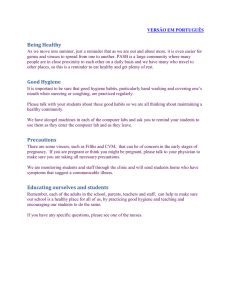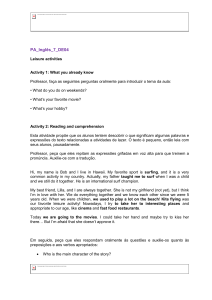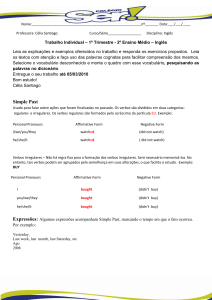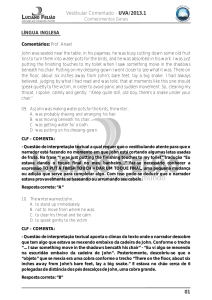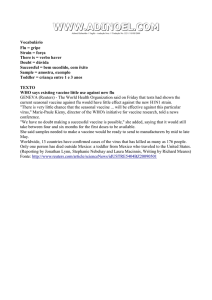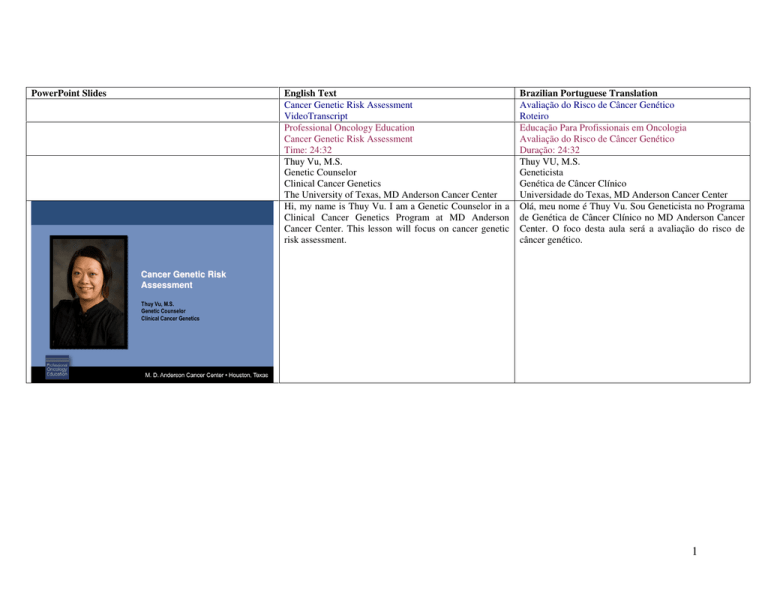
PowerPoint Slides
Cancer Genetic Risk Assessment
English Text
Cancer Genetic Risk Assessment
VideoTranscript
Professional Oncology Education
Cancer Genetic Risk Assessment
Time: 24:32
Thuy Vu, M.S.
Genetic Counselor
Clinical Cancer Genetics
The University of Texas, MD Anderson Cancer Center
Hi, my name is Thuy Vu. I am a Genetic Counselor in a
Clinical Cancer Genetics Program at MD Anderson
Cancer Center. This lesson will focus on cancer genetic
risk assessment.
Brazilian Portuguese Translation
Avaliação do Risco de Câncer Genético
Roteiro
Educação Para Profissionais em Oncologia
Avaliação do Risco de Câncer Genético
Duração: 24:32
Thuy VU, M.S.
Geneticista
Genética de Câncer Clínico
Universidade do Texas, MD Anderson Cancer Center
Olá, meu nome é Thuy Vu. Sou Geneticista no Programa
de Genética de Câncer Clínico no MD Anderson Cancer
Center. O foco desta aula será a avaliação do risco de
câncer genético.
Cancer Genetic Risk
Assessment
Thuy Vu, M.S.
Genetic Counselor
Clinical Cancer Genetics
1
Cancer Genetic Risk Assessment
Objectives
• Upon completion of this lesson, participants will
be able to:
At the end of this lesson, I hope that you should be able
to identify some family history features suggestive for
hereditary cancer syndromes; to understand what it
means for an individual and their family to have
hereditary cancer; and also to understand the benefits,
limitations, and risks of genetic testing for hereditary
cancer.
Ao final desta aula, espero que você seja capaz de
identificar algumas características de histórico familiar de
síndromes de câncer hereditárias, compreender o que
significa para um indivíduo e sua família ter câncer
hereditário e também compreender os benefícios,
limitações e riscos de testes de câncer hereditário.
With hereditary cancers, I actually focus on a very small
subset of all individuals who develop cancer. That is
because the majority of individuals who develop cancer,
it is due to sporadic causes or due to personal risk factors,
and that accounts for about 70% to 80% of cancers. There
are about 15% to 20% of cancers that are attributed to
multifactorial inheritance, which is also called familial
clustering. In these families, we see that there are
multiple --- several individuals with cancer; however,
they are diagnosed at later more typical ages of onset and
there is really no clear pattern of inheritance in these
families. With multifactorial cancers, it is due to a
combination of environmental factors as well as some
low penetrance or more subtle acting genetic factors.
Finally, only 5% to 10% of cancers are actually attributed
to inherited or genetic causes. In these families, we see
that there are very young ages of cancer onset in the
family, they occur in multiple family members, and it can
have quite a significant impact on these families. So this
is what the talk will focus on today.
No caso de cânceres hereditários, meu foco real será em
um subconjunto muito pequeno de todos os indivíduos
que desenvolvem câncer. Isto é porque na maioria dos
indivíduos que apresentam câncer se deve a causas
esporádicas ou a fatores de risco pessoal e responde por
cerca de 70% a 80% dos cânceres. Há cerca de 15% a
20% de cânceres que são atribuídos a herança
multifatorial, também chamada de agregação familiar.
Nestas famílias, vemos que há vários --- diversos
indivíduos com câncer; contudo, o diagnóstico ocorre em
idades mais avançadas e típicas de aparecimento da
doença e não há realmente um padrão nítido de herança
nestas famílias. Nos cânceres multifatoriais, isto se deve a
uma combinação de fatores ambientais, bem como baixa
penetrância ou a ação de fatores genéticos mais sutis.
Finalmente, apenas 5% a 10% dos cânceres são realmente
atribuídos a causas herdadas ou genéticas. Nestas
famílias, vemos o aparecimento de câncer em tenra idade
na família, eles ocorrem em vários familiares e podem ter
um impacto significativo nestas famílias. Este será, então,
o foco de nossa palestra hoje.
– Identify family history features suggestive for
hereditary cancer syndromes
– Understand the implications of hereditary cancer
– Understand the benefits, limitations and risks of
genetic testing for hereditary cancer
Cancer Genetic Risk Assessment
How Much of Cancer is Hereditary?
2
Cancer Genetic Risk Assessment
Risk Assessment
• With the discovery of hereditary cancer genes,
genetic testing is available as a tool to identify
patients at high risk for certain cancers
With the discovery of hereditary cancer genes, genetic
testing has become a valuable tool to identify patients at
high risk for certain types of cancers. Therefore, as health
care providers, it is your job to inquire about family
cancer history, to identify red flags within the family
history, and finally to refer these individuals and their
families to genetic counseling and testing.
Com a descoberta dos genes de câncer hereditário, os
testes genéticos passaram a ser uma valiosa ferramenta
para identificar pacientes com alto risco de certos tipos de
cânceres. Portanto, como provedores de cuidados de
saúde, sua função é perguntar sobre o histórico familiar
de câncer, identificar os sinais de alerta no histórico
familiar e, finalmente, encaminhar estes indivíduos e seus
familiares a aconselhamento e testes genéticos.
We will first talk about identifying the family history
features.
Em primeiro lugar, falaremos sobre a identificação de
características do histórico familiar.
• Role of health care providers
– Inquire about family cancer history
– Identify red flags in family history
– Refer to genetic counseling
Cancer Genetic Risk Assessment
Inquire About Family History
Paternal
Grandfather
Paternal Paternal Paternal Paternal
Uncle
Uncle
Aunt
Aunt
Sister
Sister
Maternal
Grandfather
Paternal
Grandmother
Father
Brother Brother
Daughter
Maternal
Grandmother
Mother Maternal Maternal Maternal Maternal
Uncle
Uncle
Aunt
Aunt
You
Daughter
Your
Partner
Son
Son
3
Cancer Genetic Risk Assessment
Cancer Focused Family History
• 3 generations
• Maternal and paternal families
• Cancer history
– Type of cancer
– Age at onset
– Personal risk factors
As providers, it is important to take a cancer focused
family history. This entails asking questions about three
generations of the family, to focus on both the maternal
and paternal side of the family. And for all individuals
diagnosed with cancer it is important to ask about the
type of cancers these individuals were diagnosed with,
their ages at onset as well as any personal risk factors that
may have contributed to that cancer. And for unaffected
relatives, it is important to know the ages at death or the
current ages of these individuals.
Como provedores, é importante ter um histórico familiar
com foco no câncer. Isto implica fazer perguntas sobre
três gerações da família, concentrar-se em ambos os
lados, materno e paterno, da família. E para todos os
indivíduos diagnosticados com câncer, é importante
perguntar sobre quais tipos de cânceres foram
diagnosticados, sua idade no início, bem como quaisquer
fatores de risco pessoais que possam ter contribuído para
o câncer. E quanto aos familiares não afetados, é
importante saber a idade ao óbito ou sua idade atual.
The majority of hereditary cancer syndromes are
inherited in a family in an autosomal dominant manner
with incomplete penetrance. With autosomal-dominant
inheritance, we see that there are multiple generations
affected and that the gene mutation that occurs within the
family is passed out in a 50-50 manner. Men and women
are equally affected, or at risk to inherit the mutation, and
they are at equal risk to pass on the mutation to their sons
or their daughters. The gene mutation does not skip
generations, but due to incomplete penetrance, the cancer
risk don't always occur in each individual who carries a
genetic mutation. You can see here that the individuals
shaded in orange have cancer history and have the gene
mutation; whereas these individuals in the white and with
the blue line down the middle, these individuals have the
genetic mutation, but have not inherited cancer risk. So
this individual here has not developed cancer, but several
of their children have developed cancer and you can
understand that this is an autosomal-dominant inheritance
of this cancer genetic gene.
A maioria das síndromes de câncer hereditário é herdada
em uma família de forma autossômica dominante com
penetrância incompleta. Com a herança autossômica
dominante, vemos que há várias gerações afetadas e que a
mutação genética que ocorre dentro da família é passada
em iguais proporções. Homens e mulheres são
igualmente afetados, ou em risco de herdar a mutação, e
eles estão em risco igual de passar a mutação para os
filhos ou filhas. A mutação do gene não salta gerações,
mas devido à penetrância incompleta, o risco de câncer
nem sempre ocorre em cada indivíduo que carrega uma
mutação genética. Você pode ver aqui que os indivíduos
sombreados em laranja têm histórico de câncer e têm a
mutação genética; os indivíduos no branco e com a linha
azul no meio, estes indivíduos têm a mutação genética,
mas não herdaram o risco de câncer. Então, este
indivíduo aqui não desenvolveu câncer, mas vários de
seus filhos desenvolveram câncer e você pode entender
que esta é uma herança autossômica dominante deste
gene do câncer genético.
• Unaffected relatives
– Ages at death or current ages
Cancer Genetic Risk Assessment
Autosomal Dominant Inheritance with
Incomplete Penetrance
Normal
Susceptible carrier
Carrier, affected
with cancer
Sporadic cancer
• Penetrance is often incomplete
• May appear to “skip” generations
• Individuals inherit altered cancer susceptibility
genes, not cancer
ASCO
4
Cancer Genetic Risk Assessment
The TwoTwo-Hit Hypothesis
First Hit
First Hit in
Germline of Child
Second Hit
(Tumor)
Alfred Knudson in 1971 described this Two-Hit
Hypotheses in families with heritable retinoblastoma. The
Two-Hit Hypothesis is the premise behind hereditary
cancers in the sense that individuals with hereditary
cancers inherit their first genetic mutation from a parent
or through the germline and then the second mutation
occurs in the normal allele is a somatic hit or is an
acquired mutation. This is in contrast to individuals who
have sporadic cancers. These individuals are born with
two normal copies of the gene and acquire a somatic hit
within one of the genes. And, therefore, individuals with
sporadic cancers tend to develop their cancers at later
ages of onset compared to families or individuals with
hereditary cancers.
Alfred Knudson, em 1971, descreveu a hipótese de duas
mutações em famílias com retinoblastoma hereditário. A
hipótese das duas mutações é a premissa por trás de
cânceres hereditários no sentido de que os indivíduos
com câncer hereditário herdam sua primeira mutação
genética de um dos genitores ou através da linha
germinativa e, em seguida, a segunda mutação que ocorre
no alelo normal é uma ocorrência somática ou uma
mutação adquirida. Isto, contrariamente aos indivíduos
que apresentam cânceres esporádicos. Estes indivíduos
nascem com duas cópias normais do gene e adquirem
uma mutação somática em um dos genes. E, portanto, os
indivíduos com cânceres esporádicos tendem a
desenvolver o câncer com início tardio em relação às
famílias ou indivíduos com cânceres hereditários.
After you have taken the family history of cancer, these
are some of the red flags that you should look for to
identify families that might be suspicious or concerning
to have a hereditary cancer syndrome. In these families,
we would see that there are close relatives with a same
type or related types of cancers and they all occur on the
same side of the family. The majority of these individuals
are diagnosed with cancers at much younger ages than
you would expect to see that cancer occurring. You may
see individuals with two or more primary cancers. In
organs, where there are paired organs, there may be
bilateral cancer involvement or multifocal tumors. Also
autosomal-dominant inheritance is seen in these family
histories. And if you are familiar with some of the cancer
genetic syndromes, you may recognize that the family
pattern is consistent with that particular genetic
syndrome.
Depois de obter o histórico familiar de câncer, você deve
procurar alguns sinais de alerta para identificar famílias
que tenham suspeita ou preocupação de serem portadoras
da síndrome do câncer hereditário. Nessas famílias,
veremos que existem parentes próximos com um mesmo
tipo ou tipos de cânceres afins e todos eles ocorrem no
mesmo lado da família. A maioria dessas pessoas é
diagnosticada com câncer em idade muito mais precoce
do que você esperaria ver quando da ocorrência desse
câncer. Você pode ver indivíduos com dois ou mais tipos
de câncer primário. Nos órgãos, onde há órgãos duplos,
pode haver o envolvimento de câncer bilateral ou tumores
multifocais. Além disso, vê-se a herança autossômica
dominante nestes históricos familiares. E se você está
familiarizado com algumas das síndromes genéticas do
câncer, pode reconhecer que o padrão familiar é
compatível com uma síndrome genética específica.
Jorde LB, Carey JC, White RL, Medical Genetics 2nd ed. St. Louis: Mosby; 2000
Knudson AG. Proc Natl Acad Sci USA. 1971;68:820-823
ASCO
Cancer Genetic Risk Assessment
Red Flags for Hereditary Cancer
• Clustering of the same cancer in close relatives
(on the same side of the family)
• Early age of cancer onset
• 2+ primary cancers in a single individual
• Bilateral or multifocal cancers
• Evidence of autosomal dominant inheritance
– Successive generations affected
• Family pattern consistent with a known cancer
predisposition syndrome
5
Cancer Genetic Risk Assessment
So now we will review some of the common hereditary
cancer syndromes.
Agora analisaremos algumas das síndromes hereditárias
de câncer mais comuns.
There are over two dozen hereditary cancer
predisposition syndromes, but the three that I have listed
on this page here are the ones that occur most commonly
and the ones that some of you may be more familiar with.
Amongst the hereditary breast cancer syndromes, the one
that most people are familiar with is called Hereditary
Breast and Ovarian Cancer Syndrome and this condition
is associated with mutations within the BRCA1 and
BRCA2 genes. For hereditary colorectal cancer
syndromes, most individuals are familiar with two
particular conditions. One is called Lynch syndrome,
which was previously known as Hereditary Nonpolyposis
Colorectal Cancer or HNPCC, and this condition is
associated with mutations in the DNA mismatch repair
genes. And the second hereditary colorectal cancer
syndrome is called Familial Adenomatous Polyposis or
FAP in short and this condition is associated with
mutations in the APC gene. There are numerous other
hereditary cancer syndromes as well, but we will not
focus on that.
Há mais de duas dezenas de síndromes de predisposição
hereditária de câncer, mas as três que eu tenho listadas
nesta página são as mais comuns e que alguns de vocês
devem conhecer. Entre as síndromes de câncer de mama
hereditário, a mais conhecida é a Síndrome do Câncer
Ovariano e de Mama Hereditário e esta condição está
associada a mutações nos genes BRCA1 e BRCA2.
Quanto às síndromes hereditárias de câncer colorretal, a
maioria das pessoas conhece duas delas em particular.
Uma, é a síndrome de Lynch, que era anteriormente
conhecida como Câncer Colorretal Hereditário sem
Polipose ou HNPCC; este estado clínico está associado a
mutações nos genes de reparo de DNA. A segunda
síndrome de câncer colorretal hereditária chama-se
Polipose Adenomatosa Familiar ou FAP e está associada
a mutações no gene APC. Há várias outras síndromes de
câncer hereditário também, mas não serão nosso foco.
Implications of Hereditary Cancer:
Overview of Common Syndromes
Cancer Genetic Risk Assessment
Implications of Hereditary Cancer
• Hereditary breast cancer syndromes
- Hereditary breast and ovarian cancer (BRCA1
and BRCA2 genes)
• Hereditary colorectal cancer syndromes
- Lynch syndrome (DNA mismatch
repair genes)
- Familial adenomatous polyposis (APC gene)
• Other hereditary cancer syndromes
6
Cancer Genetic Risk Assessment
Hereditary Breast and Ovarian Cancer
• Causative for the majority of hereditary breast cancers
• Germline mutations in the BRCA1 and BRCA2 genes
We will focus mostly on one particular hereditary form of
cancer and that is called Hereditary Breast and Ovarian
Cancer Syndrome. This condition accounts for the
majority of hereditary breast cancers that occur and the
condition is associated with mutations within the BRCA1
and BRCA2 genes.
Nosso foco será principalmente em uma forma específica
de câncer hereditário e se chama Síndrome do Câncer
Ovariano e de Mama Hereditário. Este estado clínico é
responsável pela maioria dos cânceres hereditários de
mama que ocorrem e está associado a mutações nos
genes BRCA1 e BRCA2.
For individuals, who carry a mutation in either one of
these genes, the cancer risks are very high. For a woman
who has a mutation with an either BRCA1 or BRCA2
genes, her lifetime risk to develop breast cancer increases
up to 50% to 85%. And once the woman has developed a
breast cancer, she has a high risk to develop a second
primary breast cancer and that risk is 40% to 60%
lifetime risk. This condition is also associated with
ovarian cancer, which can include a fallopian tube and
primary peritoneal cancers; and the lifetime risk is
approximately 15% to 45% risk. We do see other cancers
are associated with this condition and that includes men
having breast cancer, prostate cancer as well as pancreas
cancer
Para indivíduos que carregam a mutação em um destes
dois genes, os riscos de câncer são muito altos. Para uma
mulher que tenha uma mutação no gene BRCA1 ou
BRCA2, seu risco de desenvolver câncer de mama
aumenta em até 50% ou 85%. E depois que a mulher
desenvolveu um câncer de mama, ela tem alto risco de
desenvolver um segundo câncer de mama primário e o
risco é de 40% a 60%. Este estado clínico também está
associado ao câncer de ovário, que pode incluir câncer
nas tubas uterinas e peritoneal primário, e o risco é de
aproximadamente 15% a 45%. Vemos outros cânceres
que são associados a este estado clínico, incluindo
homens com câncer de mama, câncer da próstata, bem
como câncer pancreático.
Ford D., et al, Am J Hum Genet 1998
Cancer Genetic Risk Assessment
BRCA1 & BRCA2 Lifetime Cancer Risks
• Breast: 50-85%
– Second primary breast: 40-60%
• Ovarian: 15-45%
– Includes fallopian tube and primary peritoneal
cancers
• Others:
– Male breast cancer
– Prostate cancer
– Pancreatic cancer (BRCA2)
7
Cancer Genetic Risk Assessment
Red Flags for Hereditary Breast/Ovarian Cancer
• Multiple family members with ovarian cancer
or breast cancer
• Age of onset of breast cancer:
– under 50 (pre-menopausal)
• Bilateral breast cancer
• Both breast and ovarian cancer in same patient
• Ashkenazi Jewish ancestry
Family history features that are concerning for Hereditary
Breast and Ovarian Cancer Syndrome include multiple
family members with ovarian or breast cancer. And
typically these breast cancers occur at younger age of
onset, so you would see many women with
premenopausal onset of breast cancer. Women may also
have bilateral breast cancer within their lifetime or you
may see a woman with both bilateral and ovarian cancer
within her lifetime. Individuals of Ashkenazi Jewish
descent are considered to have a higher chance of having
a mutation in one of these genes than non-Ashkenazi
Jewish Caucasians. And male breast cancer is quite rare,
but it is common in this particular condition
As características de histórico familiar que sejam objeto
de preocupação para a Síndrome do Câncer Ovariano e
de Mama Hereditário englobam vários familiares com
câncer de ovário ou de mama. E em geral, estes cânceres
de mama têm início em idade mais jovem, portanto você
vê muitas mulheres com início de câncer de mama na
pré-menopausa. As mulheres podem apresentar câncer de
mama bilateral durante a vida ou você pode ver uma
mulher tanto com câncer bilateral quanto ovariano em sua
vida. Considera-se que os judeus com ascendência
asquenazita tenham maior chance de ter uma mutação em
um destes genes do que judeus caucasianos não
asquenazitas. O câncer de mama masculino é bem raro,
mas é comum neste estado clínico específico.
This is a family history that exemplifies a typical family
that may have a BRCA1 or BRCA2 gene. So you can see
here in this first generation there are several women
affected with breast cancer and ovarian cancer. This
particular woman here, she has a BRCA1 mutation, but
she has never developed cancer in her lifetime. And that
may be due to the fact that she had a complete abdominal
hysterectomy and oophorectomy when she was 46 years
old. But we will presume that she has the mutation
because her daughter was diagnosed with breast cancer at
age 59 and does have the BRCA1 mutation. So this is an
example of incomplete penetrance for hereditary cancer.
You can see here this woman was diagnosed with breast
cancer at age 52. She passed the mutation onto her son,
who has not developed any cancer history. But his
daughter developed breast cancer when she was 36 years
old; and this man’s sister had both breast cancer and
ovarian cancer. So this family exemplifies some of the
typical family history features that we would see
commonly in this condition.
Este é um histórico familiar que exemplifica uma família
típica que talvez tenha um gene BRCA1 ou BRCA2.
Assim, você pode ver aqui, nesta primeira geração, que
há várias mulheres afetadas com câncer de mama e
câncer de ovário. Especialmente esta mulher aqui, ela tem
uma mutação BRCA1, mas nunca desenvolveu câncer. E
isso pode ser devido ao fato de que ela passou por uma
histerectomia abdominal radical e ooforectomia quando
tinha 46 anos. Mas suponhamos que ela apresente a
mutação, pois sua filha foi diagnosticada com câncer de
mama aos 59 anos e apresenta a mutação BRCA1.
Portanto, este é um exemplo de penetrância incompleta
para câncer hereditário. Você pode ver aqui esta mulher
que foi diagnosticada com câncer de mama aos 52 anos.
Ela passou a mutação para o filho, que não desenvolveu
nenhum histórico de câncer. Mas a filha dele desenvolveu
câncer de mama aos 36 anos de idade; a irmã deste
homem teve tanto câncer de mama quanto câncer
ovariano. Portanto, esta família exemplifica algumas das
características típicas de histórico familiar que veríamos
normalmente neste estado clínico.
• Male breast cancer
Cancer Genetic Risk Assessment
Family History of Hereditary Breast/Ovarian Cancer
Deceased
92
Br Ca, dx 52
86
d. 51
Br Ca, dx 45 TAH/BSO, 46
Noncarrier of
mutation
BRCA 1 mutation
carrier, unaffected
73
68
71
d.47
Br Ca, dx 40
Ov Ca, dx 45
65
Br Ca, dx 59
BRCA 1 mutation
carrier with cancer
34
36
Br Ca, dx 36
Br Ca = Breast cancer
Ov Ca = Ovarian cancer
ASCO
8
Cancer Genetic Risk Assessment
Management Options for HBOC
• Breast Cancer
– Increased surveillance – mammogram plus breast MRI every
12 months, clinical breast exams every 6 months, beginning
at age 25
– Chemoprevention – tamoxifen
– Risk reducing bilateral mastectomy
• Ovarian Cancer
– Surveillance – no proven benefit – transvaginal ultrasound
and CA-125 blood test every 6 months, beginning at
age 35
– Chemoprevention – oral contraceptives
– Risk reducing bilateral salpingo-oophorectomy
NCCN v1.2010
Cancer Genetic Risk Assessment
Implications of Hereditary Cancer: Summary
• Unique family history features
• Increased cancer surveillance and management
– Begin at younger ages
– Increased frequency
• Range of management options
• High-risk cancer management clinics
often available
For families that have this condition, we do recommend
that they follow with high-risk cancer surveillance and
management options. And these recommendations that I
am discussing here are based on the National
Comprehensive Cancer Network. For breast cancer, we
recommend that women undergo increased surveillance.
This would include mammogram plus breast MRI every
12 months, a clinical breast exam every six months and
that the screening begins at age 25 years. Women may
also consider tamoxifen chemoprevention as well as riskreducing bilateral mastectomy. For ovarian cancer risk,
although the surveillance has no proven benefit, we do
recommend that women consider a transvaginal
ultrasound and a CA125 blood serum marker performed
every six months beginning at age 35. Oral
contraceptives may be a chemopreventative option and
some women may also consider risk-reducing bilateral
salpingo-oophorectomy.
Às famílias que apresentem este estado clínico,
recomendamos que sigam opções de vigilância e
gerenciamento do câncer de alto risco. E estas
recomendações que estou discutindo baseiam-se na
National Comprehensive Cancer Network. Quanto ao
câncer de mama, recomendamos que as mulheres passem
por maior vigilância. Seriam mamograma mais RM da
mama a cada 12 meses, um exame de mama clínico a
cada seis meses e a triagem começaria aos 25 anos. As
mulheres também podem considerar quimioprevenção
com tamoxifeno, bem como mastectomia bilateral para
redução de risco. Quanto ao risco de câncer de ovário,
embora a vigilância não tenha benefício comprovado,
recomendamos
que
as
mulheres
considerem
ultrassonografia transvaginal e um marcador tumoral de
sangue CA125 a cada seis meses, com início aos 35 anos.
Contraceptivos orais podem ser uma opção de
quimioprevenção e algumas mulheres também podem
considerar salpingo-ooforectomia bilateral para redução
de risco.
In summary, for families that have hereditary cancer, we
do recognize that there are very unique family history
features and they do follow the red flags for hereditary
cancer that we previously discussed. These family
members are recommended to undergo increased cancer
surveillance and management. And typically this begins
at younger ages and at much increased frequency
compared to the general population and there is a range
of management options for these family members. And
often within the United States, there are high-risk cancer
management clinics available to coordinate all of these
high-risk screening.
Em resumo, para as famílias que apresentam câncer
hereditário, temos que reconhecer que há características
únicas no histórico familiar e que elas seguem os sinais
de alerta para o câncer hereditário que discutimos
anteriormente. Recomenda-se que estes familiares
passem por maior vigilância e gerenciamento. E,
normalmente, isso começa em idades mais jovens e em
frequência muito maior em comparação com a população
em geral e há uma gama de opções de gerenciamento
para estes familiares. E, muitas vezes, dentro dos Estados
Unidos, há clínicas de gerenciamento de câncer de alto
risco disponíveis para coordenar todas essas triagens de
alto risco.
9
Cancer Genetic Risk Assessment
Finally, we will review the genetic counseling and testing
process.
Finalmente, examinaremos o aconselhamento genético e
processo de teste.
Genetic counseling is a process of providing information
about an inherited condition to an individual or their
family, of also providing supportive counseling to the
families and providing these families with resources.
Aconselhamento genético é um processo de fornecimento
de informações sobre uma doença herdada de um
indivíduo ou sua família e também de prestar
aconselhamento de apoio às famílias, fornecendo-lhes
recursos.
Genetic Counseling & Testing Process
Cancer Genetic Risk Assessment
Genetic Counseling
A process of:
• Providing information about an inherited
condition to an individual or family
• Providing supportive counseling to families
• Providing families with resources
10
Cancer Genetic Risk Assessment
Genetic Counseling Process
• Risk assessment
– Multi-generation pedigree
– Clarification/documentation of reported cancer
family history
• Identification of appropriate family member to test
• Interpretation of genetic test results
• Psychosocial and insurance issues
• Individualized screening recommendations
Cancer Genetic Risk Assessment
Genetic Testing Process
Not all patients seen for risk
assessment are offered
genetic testing
Geller G et al. JAMA. 1997;277:1476-1474
Offit K.Clinical Cancer Genetics: Risk Counseling and Management. New York: Wiley-Liss; 1998
Schneider K. Counseling about Cancer: Strategies for Genetic Counseling. 2nd ed New York: John Wiley & Sons
2001
ASCO
So once you have done your part in identifying the
appropriate family history features that are concerning for
hereditary cancer and have recommended a referral to
genetic counseling for these families, they do see us for
the genetic counseling and that includes a risk assessment
of their family history. We will take a three-generation
family history, focus on clarifying the reported cancer
histories, as well as looking at all the individuals who
have not developed cancer. From the risk assessment, we
will identify whether genetic testing is appropriate for the
family to consider, and importantly identifying who in
the family is the most important person to initiate the
genetic testing process. If genetic testing is pursued in the
family, we will discuss interpretation of the genetic test
results and also we will discuss psychosocial and
insurance issues surrounding the genetic counseling and
genetic testing process. And whether testing is pursued or
not,
we
discuss
individualized
screening
recommendations based on the family history.
The genetic testing process is a multistep process. The
first step is that we need to identify who is at risk for
having --- potentially having this hereditary cancer
syndrome. Now not all patients seen for the genetic risk
assessment are actually offered genetic testing. It is
important to identify the most informative family
member. Once genetic testing is discussed with the
family, we want to provide very detailed pre-test
information --- pretest counseling providing informed
consent to the family or the individual undergoing
testing. And then once the results are disclosed to the
patient, provide detailed post test counseling and
followup regarding management.
Então, depois de ter feito sua parte na identificação das
características de histórico familiar apropriadas que são
preocupantes para o câncer hereditário e recomendar um
encaminhamento para aconselhamento genético para
essas famílias, a consulta conosco inclui uma avaliação
de risco do histórico familiar. Veremos o histórico
familiar de três gerações, com foco em esclarecer os
históricos de câncer reportados, bem como examinar
todos os indivíduos que ainda não desenvolveram câncer.
A partir da avaliação de risco, identificaremos se o teste
genético é apropriado para a família considerar e, mais
importante, identificar quem na família é a pessoa mais
importante para iniciar o processo de testes genéticos. Se
o teste genético for realizado na família, discutiremos a
interpretação dos resultados de testes genéticos e também
as questões psicossociais e de seguro em torno do
processo de aconselhamento e testes genéticos. E se o
teste for realizado ou não, discutiremos as recomendações
de triagem individualizada com base no histórico
familiar.
O processo de testes genéticos tem várias etapas. O
primeiro passo é que precisamos identificar quem está em
risco de apresentar --- potencialmente apresentar esta
síndrome de câncer hereditário. Agora, a oferta de testes
genéticos não é feita a todos os pacientes atendidos para a
avaliação de risco genético. É importante identificar o
membro da família que ofereça mais informações. Uma
vez que o teste genético é discutido com a família,
queremos dar informações muito detalhadas antes do
teste --- aconselhamento pré-teste proporcionando o
consentimento livre e esclarecido para a família ou o
indivíduo submetido aos testes. E quando os resultados
são divulgados ao paciente, fornecemos aconselhamento
e acompanhamento pós-teste detalhados, pertinentes ao
gerenciamento.
11
Cancer Genetic Risk Assessment
American Society of Clinical Oncology:
Policy Statement
• Indications for genetic testing for cancer susceptibility
– Personal/family history features suggestive of hereditary
cancer syndrome
– Test can be adequately interpreted
– Results will aid in diagnosis or medical management
• Genetic testing should be done in setting of preand post-counseling
The American Society of Clinical Oncology has issued a
policy statement back in 2003 based on recommending
indications for genetic testing for cancer susceptibility
and there are three premises to their recommendation.
The first is that the personal or family history actually is
suggestive for a particular hereditary cancer syndrome;
that the tests being offered can be adequately interpreted;
and that the results of the testing will actually aid in the
diagnosis or medical management for that individual or
their family. An important emphasis is that the genetic
testing should always be done in the setting of post- [I am
sorry] --- in the setting of pre- and post-test counseling
A Sociedade Americana de Oncologia Clínica publicou
uma política em 2003 com base em indicações para
recomendar testes genéticos para suscetibilidade ao
câncer, e há três premissas para a sua recomendação. A
primeira é que o histórico pessoal ou familiar seja
verdadeiramente sugestivo de uma síndrome de câncer
hereditário em particular, que os testes que estão sendo
oferecidos possam ser adequadamente interpretados e que
os resultados dos testes realmente sirvam de ajuda no
diagnóstico ou tratamento médico para aquele indivíduo
ou seus familiares. É importante enfatizar que o teste
genético deve ser feito sempre no contexto de pós[desculpem] --- no cenário de aconselhamento pré e pósteste.
Other considerations regarding genetic testing that
families consider is that there is quite a wide range of
possible emotional reactions for the patient as well as
members of their family. It is important to ask the family,
"How do they intend on using this information?" The
patient or the person undergoing the genetic testing.
"How do they intend to share this information with the
rest of their family members?" And to focus on how the
genetic test results may change their cancer screening and
health management. So this will provide a lot of useful
information for their health care team. Many patients also
want to know the more logistical aspects of genetic
testing such as the costs involved, the timeframe to
receive the results, and the majority of patients do express
concerns about genetic discrimination and we have a lot
of resources that we can share with the families
Outras considerações sobre testes genéticos que as
famílias ponderam é que haja uma gama bastante ampla
de possíveis reações emocionais para o paciente, bem
como para seus familiares. É importante perguntar à
família: "Como vocês pretendem usar esta informação?"
O paciente ou a pessoa submetida ao teste genético.
"Como vocês pretendem compartilhar esta informação
com os outros familiares?" E se concentrar em como os
resultados dos testes genéticos podem mudar a triagem do
câncer e o gerenciamento da saúde. Então, isso trará
muitas informações úteis para sua equipe de cuidados de
saúde. Muitos pacientes também querem saber os
aspectos mais logísticos dos testes genéticos, como os
custos envolvidos, o prazo para receber os resultados; a
maioria dos pacientes manifesta preocupação diante de
discriminação genética, mas temos uma grande
quantidade de recursos que podemos compartilhar com os
familiares.
J Clin Oncol 2003; 21(12):2397-2406
Cancer Genetic Risk Assessment
Genetic Testing: Other Considerations
• Wide range of possible emotional reactions
• How will the patient and their family use
this information?
– Sharing genetic test results with family members
– May change cancer screening and health management
• Cost of genetic testing
• Concerns of genetic discrimination
12
Cancer Genetic Risk Assessment
Benefits of Genetic Testing
• Provides information about one’s cancer risk
• Helps determine the cancer risk for family members
• May assist in making decisions about cancer
screening or management
• May provide relief from uncertainty
• May identify individuals who are not at risk in families
with known mutations
Cancer Genetic Risk Assessment
Limitations of Genetic Testing
• Cannot determine with certainty if or when a
cancer will develop
• A negative result cannot rule out an increased
cancer risk
• Screening and prevention measures are not
100% effective
• All individuals have a background risk for cancer
Some of the benefits of genetic testing include the ability
to provide information to clarify one’s cancer risk, to help
determine the cancer risk for their family members. And
this is a big motivation for many individuals to undergo
genetic testing and counseling. The genetic test results
may also aid in making decisions about cancer screening
or management. Many families, they experience a sense
of relief from uncertainty once the hereditary syndrome
has actually been identified in the family or the genetic
testing has ruled out that they have not inherited this
cancer susceptibility gene. And finally, genetic testing
may identify individuals who are not at high risk in
families with no mutations and this definitely provides a
great sense of relief from knowing that they are not at
high risk for certain types of cancers.
Alguns dos benefícios dos testes genéticos incluem a
capacidade de fornecer informações para esclarecer o
risco do câncer para uma pessoa e ajudar a determinar o
risco de câncer para seus familiares. E esta é uma grande
motivação para muitos indivíduos se submeterem a testes
e aconselhamento genético. Os resultados dos testes
genéticos também podem auxiliar na tomada de decisões
sobre a triagem ou gerenciamento do câncer. Muitas
famílias experimentam uma sensação de alívio em
relação à incerteza após a identificação da síndrome
hereditária na família ou se os testes genéticos
descartaram a possibilidade de não terem herdado esse
gene de suscetibilidade ao câncer. E, finalmente, os testes
genéticos podem identificar os indivíduos que não estão
em alto risco em famílias sem mutações e isso
definitivamente proporciona uma grande sensação de
alívio em saber que não estão em alto risco para certos
tipos de cânceres.
Unfortunately, there are some limitations to genetic
testing. The testing cannot determine with certainty if or
when a cancer will develop and this goes back to the
incomplete penetrance that we discussed earlier. A
negative genetic test result cannot actually rule out an
increased cancer risk. And we will talk about the
implications and interpretation of genetic test results in a
bit. Screening and prevention measures are not 100%
effective and all individuals must be reminded that we all
have a background risk for cancer development.
Infelizmente, existem algumas limitações para testes
genéticos. O teste não pode determinar com certeza se ou
quando um câncer desenvolver-se-á e isto remete à
penetrância incompleta que discutimos anteriormente.
Um resultado negativo do teste genético na verdade não
pode afastar um risco maior de câncer. E logo falaremos
sobre as implicações e interpretação dos resultados dos
testes genéticos. As medidas de triagem e prevenção não
são 100% eficazes e todos os indivíduos devem ser
lembrados de que todos nós temos um risco a priori para
o desenvolvimento do câncer.
13
Cancer Genetic Risk Assessment
Basics of Genetic Testing
Type of Test
Comments
Full Gene Analysis
Analyzes entire gene
for mutations
• May not identify all mutations
• May identify uncertain variants
Known Mutations Testing
Testing for mutation
previously identified in family
• Best method once family mutation
is found
• 100% accuracy for family members
Multi-site Testing
Testing for panel of
specific mutations
• Testing for population-specific
founder mutations
So, some of the basic concepts of genetic testing include
the type of genetic test that would be offered to the
family. There are several types including full gene
analysis, known mutation testing, and Multi-Site testing.
For full gene analysis, this involves analyzing the entire
gene for mutations. Some of the limitations of this are
that not all mutations are identifiable with today’s current
genetic testing technology. And also we may identify
variants or genetic alterations that have uncertain clinical
significance. And this can be quite frustrating for the
genetic provider as well as the patient and their family.
However, once the mutation has been identified in the
family, then at-risk relatives can undergo what is called
known mutation testing and this is testing for a mutation
that has previously been identified in the family. This is
actually the best method once the mutation is found in the
family because it provides 100% accuracy whether an
individual has inherited the genetic susceptibility gene or
not. For some genetic testing, we actually initiate the
testing process with what is called Multi-Site testing and
this is testing for a panel of specific mutations. I
mentioned earlier that one of the red flags for Hereditary
Breast and Ovarian Cancer Syndrome is that an
individual of Ashkenazi Jewish descent may have a high
risk of having a BRCA1 and BRCA2 gene change. For
these individuals, we would actually offer Multi-Site
testing for the three Ashkenazi Jewish founder mutations.
Assim, alguns dos conceitos básicos de testes genéticos
incluem o tipo de teste genético que seria oferecido à
família. Há vários tipos, incluindo a análise genética
completa, testes de mutação conhecida e testes em vários
locais. A análise completa do gene envolve a análise do
gene inteiro quanto a mutações. Algumas das limitações
são que nem todas as mutações são identificáveis com a
tecnologia atual de testes genéticos. E também podemos
identificar as variantes e as alterações genéticas que têm
significância clínica incerta. Isto pode ser bastante
frustrante para o provedor de teste genético, o paciente e
sua família. No entanto, uma vez que a mutação foi
identificada na família, então parentes em risco podem
sofrer o que é chamado de teste de mutação conhecida e
este é o teste para uma mutação que tenha sido
previamente identificada na família. Este é realmente o
melhor método, pois quando a mutação é encontrada na
família, há precisão de 100% se um indivíduo herdou o
gene de suscetibilidade genética ou não. Para alguns
testes genéticos, realmente iniciar o processo de testes
chamado teste em vários locais e este é o teste de um
painel de mutações específicas. Mencionei anteriormente
que dos sinais de alerta da Síndrome de Câncer de Mama
e de Ovário Hereditário é que um judeu de ascendência
asquenazita pode ter risco elevado de mudança no gene
BRCA1 e BRCA2. Para estes indivíduos, oferecemos
testes em muitos locais para as três mutações em judeus
asquenazitas.
14
Cancer Genetic Risk Assessment
Possible Genetic Test Results
Test Result
Comments
Positive
Deleterious mutation
identified
• Confirms diagnosis of cancer syndrome
• Family members can definitively clarify their
risk to inherit syndrome
True Negative
• No mutation detected
• Family mutation known
• Reassuring that individual has not inherited
the cancer syndrome
• Cancer risks return to general population
Cancer Genetic Risk Assessment
Possible Genetic Test Results
Test Result
Comments
Uninformative Negative
• No mutation detected
• No mutation previously
identified in the family
• Familial mutation cannot be ruled out
• Consider testing another affected
family member
• Cancer risk management based on
family history
Uncertain Variant
• Testing affected family members
DNA change identified
but clinical significance
is unknown
(only) can also help determine
segregation with cancer
• Cancer risk management based on
family history
Once an individual pursues genetic testing, there are
several types of results that can be anticipated. The first
type of result is called a positive result. This means that a
deleterious or disease-causing mutation has been
identified in the family. This really means that -- this
confirms the diagnosis that the family has this particular
hereditary cancer syndrome. And having a positive result
allows family members to definitively clarify whether
they have inherited the condition or not and they can then
pursue the known mutation testing. Another type of result
we can expect to receive is called a true negative result.
True negative results can be anticipated in individuals
who pursue known mutation testing. This is because they
are testing only for that mutation that has already been
identified in the family and they have tested negative for
this. So, we know that they have truly not inherited this
gene for cancer susceptibility and this is a very reassuring
result for the individual. And these individuals have the
same cancer risk as anyone else in the general population
now.
These two types of results have a little bit more
ambiguity in interpretation and it is important to return to
the family history to help interpret these results. An
uninformative negative result can be received when --- [I
am sorry] --- full gene mutation testing is pursued. With
uninformed negative results, it means that no mutation
has previously been identified in the family and this
person has tested also negative for any mutations in that
gene. So in these cases the family mutation still cannot be
ruled out. Oftentimes, we return to the family history to
see if there is a better, more informative test candidate or
a family member that could undergo the same genetic
testing. And the cancer risk management is based back on
the family history and the pattern of cancers that we see.
The last type of result we may anticipate receiving is
called an uncertain variant. This means that a DNA
change or alteration was identified from the genetic
Quando um indivíduo procura testes genéticos, há vários
tipos de resultados que podem ser previstos. O primeiro é
o resultado positivo. Isto significa que uma mutação
deletéria ou causadora de doenças foi identificada na
família. Isso realmente significa que --- isto confirma o
diagnóstico de que a família tem essa síndrome de câncer
hereditário específica. Com o resultado positivo, os
familiares podem afinal esclarecer se herdaram a
condição ou não e realizar o teste para a mutação
conhecida. Outro tipo de resultado que se pode esperar é
o resultado negativo verdadeiro. Os resultados negativos
verdadeiros podem ser previstos em indivíduos que
procuram um teste de mutação conhecida. Isso é porque
eles estão realizando o teste apenas para aquela mutação
que já tenha sido identificada na família e cujo teste para
eles foi negativo. Portanto, sabemos que eles realmente
não herdaram este gene de suscetibilidade ao câncer, o
que é um resultado muito reconfortante para o indivíduo.
E estes indivíduos apresentam o mesmo risco de câncer
de toda a população.
Estes dois tipos de resultados apresentam um pouco mais
de ambiguidade na interpretação e é importante retornar
ao histórico familiar para ajudar na interpretação destes
resultados. Um resultado negativo não informativo pode
ser recebido quando --- [desculpe] --- se buscar um teste
de mutação de genes completo. No caso de resultados
negativos não informativos, isto significa que não houve
mutação previamente identificada na família e os
resultados de testes deste indivíduo foram negativos para
quaisquer mutações naquele gene. Portanto, nestes casos,
não se pode descartar a mutação familiar. Muitas vezes,
voltamos ao histórico familiar para ver se existe um
candidato melhor ao teste, mais informativo ou um
familiar que poderia passar pelo mesmo teste genético. E
o gerenciamento de risco de câncer fundamenta-se no
histórico familiar e no padrão de cânceres que vemos. O
último tipo de resultado chama-se variante incerta. Isto
15
testing, but the clinical significance is unknown. In this
case, testing affected family members only, can help
determine whether the gene mutation or gene alteration is
segregating with cancer. But there is no utility in testing
unaffected family members because we do not know how
to interpret these results. The cancer risk management is,
therefore, based on the family history of cancer
Cancer Genetic Risk Assessment
Risk Management
• Regardless if patient pursues genetic testing,
we discuss:
– Individualized cancer screening
– Prevention
– Medical management options, including referrals
to appropriate specialists
• Recommendations based on either positive genetic
test results or family history
Regardless of whether the patient pursues genetic testing,
risk management options for cancer are always discussed.
We provided detailed individualized cancer screening and
a prevention plan based on review of the three-generation
family history and we discuss medical management
options including referrals to appropriate specialists. So,
while some families may not actually have a gene
mutation identified in the family, the family history
features may be still concerning for hereditary cancer and
a referral to high-risk screening clinics may still be
indicated for the family.
significa que uma mudança ou alteração no DNA foi
identificada no teste genético, mas não se conhece sua
significância clínica. Neste caso, o teste que afetou
apenas os familiares pode ajudar a determinar se a
mutação do gene ou alteração do gene está relacionada
com câncer. Mas não há nenhuma utilidade em testes de
familiares não afetados porque não sabemos como
interpretar estes resultados. E o gerenciamento de risco
de câncer fundamenta-se, portanto, no histórico familiar
de câncer.
Independentemente de o paciente procurar testes
genéticos, as opções de gerenciamento de risco para o
câncer são sempre discutidas. Oferecemos triagem e um
plano de prevenção contra o câncer detalhados e
individualizados com base na análise do histórico
familiar para três gerações e discutimos as opções de
gerenciamento clínico, inclusive encaminhamento a
especialistas apropriados. Assim, enquanto não é possível
identificar uma mutação genética na família, as
características de histórico familiar ainda podem se
referir ao câncer hereditário e, para esta família, talvez
seja indicado o encaminhamento a clínicas para triagem
de alto risco.
16
Cancer Genetic Risk Assessment
Genetic Information Discrimination Act of 2008
(GINA 2008)
• Federal legislation signed into law on May 21, 2008
• Prohibits discrimination in health coverage and
employment based on genetic information
• “Genetic information”
– An individual or family member’s genetic tests
– Family history
– Genetic testing, counseling or education by an
individual or family member
Many families are very concerned about the possibility of
genetic discrimination. In 2008, Congress passed a law
called Genetic Information Nondiscrimination Act. This
is also known as GINA. And GINA prohibits
discrimination in health coverage and employment based
on genetic information. Genetic information is defined as
an individual or their family members’ genetic test
results, their family history alone, and information
obtained from the genetic testing, counseling, or
education process by a family member. To learn more
about GINA, you can go to this link listed at the bottom
of the page.
Muitas famílias estão muito preocupadas com a
possibilidade de discriminação genética. Em 2008, o
Congresso
aprovou
a
Genetic
Information
Nondiscrimination Act (Lei sobre Informações Genéticas
Não Discriminatórias), também conhecida como GINA,
que proíbe a discriminação para cobertura de saúde e
emprego com base em informações genéticas. Define-se
informação genética como os resultados de testes de um
indivíduo ou familiares, seu histórico familiar apenas e as
informações obtidas de teste , aconselhamento ou
processo de educação genéticos por um familiar. Ao final
desta página, há um link para saber mais sobre a GINA.
Prior to the passage of GINA in 2008, approximately 47
states have passed laws pertaining to genetic
discrimination. These states had variable protections for
the requirement of genetic test and information, eligibility
and risk classification by health --- group health insurers.
And states --- now with the passage of GINA, states that
had less protection than GINA will actually need to
comply with minimum protections of GINA. So this can
be good news for families in which you have family
members scattered all across the United States because
GINA provides a blanket law regardless of where you
live in or if you plan on moving to other states. To
actually learn about your specific state laws, you can to
go the National Conference of State Legislatures and look
up more information on that.
Antes da aprovação da GINA em 2008, cerca de 47
estados já haviam aprovado leis relativas à discriminação
genética. Estes estados ofereciam proteção variável para a
exigência de teste e informação genética, qualificação e
classificação de risco por saúde --- seguradoras de saúde
em grupo. Os estados --- agora com a aprovação da
GINA, os estados que ofereciam menos proteção do que a
GINA realmente precisam cumprir as proteções mínimas
da lei. Portanto, isto pode ser bom para famílias
espalhadas pelos Estados Unidos, pois a GINA oferece
cobertura onde você mora, independentemente de onde
você morar ou se mudar de estado. Para conhecer mais
sobre as leis específicas de seu estado, consulte a
National Conference of State Legislatures para obter mais
informações.
• National Human Genome Research Institute
http://www.genome.gov/10002077
Cancer Genetic Risk Assessment
State Laws on Genetic Discrimination
• 47 states have laws pertaining to genetic
discrimination
• Variable protections for requirement of genetic
test/information, eligibility and risk classification
by insurers
• States with less protection than GINA will need
to comply to minimum protections of GINA
• National Conference of State Legislatures
http://www.ncsl.org
– Issues & Research > health > genetic nondiscrimination
in health insurance laws
17
Cancer Genetic Risk Assessment
Genetic Counseling & Testing: Summary
• Not everyone who presents for risk assessment
will be offered genetic testing
• Emphasis on pre- and post-test counseling
• Not all genetic test results are unequivocal
• Cancer risk management based on positive test
results or family history
• Consider emotional and psychological impact
on family
• Federal and state legislation for genetic discrimination
Cancer Genetic Risk Assessment
Summary
• Concerning family histories warrant referral to genetic
consultation
– Young onset cancer, multiple affected relatives,
successive generations, bilateral/multifocal cancers
• Genetic consultation is a risk assessment of
personal, medical and family histories for hereditary
cancer syndromes
• Genetic testing not appropriate for everyone
• Implications for increased surveillance and cancer
management for families with hereditary cancer
susceptibility syndromes
In summary, not everyone who presents for genetic
counseling will actually be offered genetic testing. The
genetic counseling process focuses on providing both
pre- and post-test genetic counseling. Not all genetic test
results are considered unequivocal. We often have to
return to the family history for interpretation of these
results and also make cancer risk management
recommendations based on either the family history or
whether a positive genetic test result has been identified
in the family. With the genetic counseling and genetic
testing process, it is very important to consider the
emotional and psychological impacts on the family; as
different family members will perceive these results in
very different ways. And finally there are federal and
state legislation for genetic discrimination.
Em resumo, não se oferece testes genéticos a todos os
que se apresentam para aconselhamento genético. O
processo de aconselhamento genético se concentra em
oferecer aconselhamento pré e pós-teste. Nem todos os
resultados de teste são considerados claros.
Frequentemente, temos que voltar ao histórico familiar
para a interpretação destes resultados e também para
fazer recomendações de gerenciamento de risco de câncer
com base ou no histórico familiar ou se foi identificado
um resultado positivo de teste genético na família. Em
relação ao processo de aconselhamento genético e teste
genético, é muito importante considerar o impacto
emocional e psicológico na família, pois cada familiar
percebe os resultados de maneira diferente. E, finalmente,
há leis federais e estaduais sobre discriminação genética.
In summary, there are many concerning family histories
that we have discussed today. And if you have identified
a family that meets any of these red flags for hereditary
cancer, please make a referral for genetic counseling for
these individuals. This will include families with young
onset of cancer, multiple affected family members
occurring in multiple generations, and individuals with
bilateral multifocal or multiple primary cancers. The
genetic consultation visit is a risk assessment of an
individual’s personal, medical, and family histories for
hereditary cancer syndrome. And although patients may
undergo genetic counseling, genetic testing may not
always be recommended for that individual or their
family and, therefore, it may not be appropriate for
everyone. Whether testing is discussed or pursued by the
patient, implications for increased screening and cancer
risk management are always discussed based on the
family cancer pattern. This concludes my presentation.
Thank you for your time.
Em resumo, há vários históricos familiares preocupantes
que discutimos hoje. E se você identificou uma família
que atende aos critérios de qualquer um destes sinais de
alerta para câncer hereditário, encaminhe estes indivíduos
para aconselhamento genético. Isto incluirá famílias com
início de câncer em idade precoce, vários familiares
afetados ocorrendo em várias gerações e os indivíduos
com cânceres multifocais bilaterais ou vários cânceres
primários. A consulta genética é uma avaliação de risco
do histórico pessoal, médico e familiar de um indivíduo
em relação à síndrome de câncer hereditário. E embora os
pacientes possam passar por aconselhamento genético, o
teste genético nem sempre pode ser recomendado para
esse indivíduo ou sua família e, portanto, pode não ser
apropriado para todos. Se o teste é discutido ou procurado
pelo paciente, sempre são discutidas as implicações de
maior triagem e gerenciamento de risco de câncer com
base no padrão de câncer familiar. Isso conclui minha
apresentação. Obrigada pela atenção.
18



